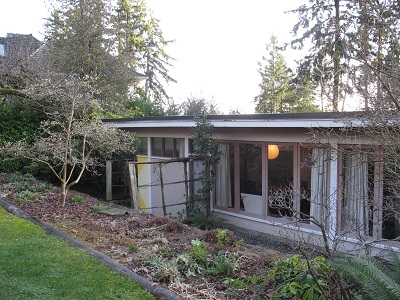Binning Residence National Historic Site of Canada
West Vancouver, British Columbia

Exterior view of the residence
© Parks Canada | Parcs Canada
Address :
2968 Mathers Crescent, West Vancouver, British Columbia
Recognition Statute:
Historic Sites and Monuments Act (R.S.C., 1985, c. H-4)
Designation Date:
1998-03-12
Dates:
-
1941 to 1941
(Construction)
Event, Person, Organization:
-
C.E. Pratt
(Architect)
-
B.C. Binning
(Architect)
-
R.A.D. Berwick
(Architect)
Other Name(s):
-
Binning Residence
(Designation Name)
Research Report Number:
1997-081
Plaque(s)
Existing plaque: 2968 Mathers Crescent, West Vancouver, British Columbia
Daring and innovative, this house captures the spirit of early Modern architecture in Canada. Conceived by renowned painter Bertram Charles Binning in 1941, it responded to the social and economic conditions of the time by using local materials and efficient construction methods to create an affordable home. The design is based on contemporary lifestyle patterns, incorporating abstract murals and the surrounding landscape. Harmonizing art and architecture, form and function, the Binning residence inspired many architects across Canada over the following decades.
Description of Historic Place
Binning Residence National Historic Site of Canada is located on a small, steeply sloped site on a well-treed and quiet residential street in West Vancouver, British Columbia, with a view of Burrard Inlet. A small two-bedroom house, it consists of two rectangular volumes that are stepped down to take advantage of the natural topography of the site. With its low massing and flat roof and situation within mature vegetation, the residence virtually disappears into the landscape. The official recognition refers to the house and its lot at the time of designation.
Heritage Value
Binning Residence was designated a national historic site of Canada because: it is an early and remarkably intact illustration of architecture in the Modern Era; it is clearly associated with the changing social, economic, and political conditions of the day; it demonstrates meaningful interrelationships between form and function, and architecture and art; its design has had a lasting and important impact on the work of artists, architects, and other Canadians across the country.
The Binning Residence constitutes a very early illustration of the Modern movement in residential architecture in Canada. Intended to provide a model for residential design, it combines a Modern approach to form and function with an economy and efficiency of construction by using local materials and up-to-date building technologies. Features such as its post-and-beam construction, simple rectangular volumes with flat roofs and deep overhangs, large windows and open interior plan, set a pattern of design that would influence post-war residential architecture throughout the 1950s and 1960s. Designed and constructed during the war when construction materials and labour were difficult to secure for private homes, the Binning Residence utilized traditional and local materials to produce a house type that could be mass produced and was affordable for the average family. The design is also noted for the careful integration of architecture and landscape. The building’s stepped plan follows the slope of the land and the use of large windows, wide terraces and overhanging trellises have the effect of extending the architecture out into the landscape and breaking down the barriers between interior and exterior space.
Bertram Charles Binning (1909-1976), an artist and a leading promoter of Modernist ideology, deemed architecture to be the harmonious expression of science and society. He designed the house in collaboration with consulting architects C.E. Pratt and R.A.D. Berwick, to express the union of abstract art and new architectural forms. To that end, he included a gallery in the house to accommodate a changing selection of his paintings, ensuring that his domestic environment evolved with his art. Believing that the aesthetic criteria of harmony, integrity, order and balance applied to art and architecture alike, Binning worked as an artist and a teacher, promoting good architectural design in contemporary urban life.
Although the landscape has evolved, the original artwork has been replaced by later Binning pieces, and minor modifications and repairs to the house have occurred, the original design intent has not been compromised.
Source: Historic Sites and Monuments Board of Canada, Minutes, November 1997.
Character-Defining Elements
Key elements that contribute to the heritage character of the Binning Residence include: its location on a quiet residential street in West Vancouver, British Columbia; its setting on a steeply sloped site; its orientation to views across the Burrard Inlet to the University of British Columbia’s endowment lands, as well as to views from the house to the mature garden and a series of garden terraces adjacent to the studio and master bedroom; its rectangular form, small scale and low massing; the flat roof with deep overhangs; the post-and-beam construction on a reinforced concrete foundation; the open plan concept with efficient space planning; the use of hard and soft wood millwork and floors, and cedar v-joint vertical board cladding on both the interior and exterior walls; the original fenestration pattern with south facing clerestory windows, continuous floor to ceiling doors, tinted glass in the studio, tinted rolled ribbed glass set in the upper portion of the partition between the living-dining area and the long gallery-entrance hallway; the upper terrace extending from the living room square and terraces on the south, east, and north sides; the overhanging wooden shade screen; the Binning mural on the exterior wall that defines the principle entrance; the cantilevered canopy over the front door; the generously proportioned living-dining area dominated by a Cypress Creek fieldstone fireplace wall; the kitchen with U-shaped layout of custom-made fir plywood cabinets fitted with standard chrome handles and modern appliances; the period furniture, fixtures and art collection; the landscape elements including a Japanese maple, mature rhododendrons and a grapevine planted by the Binnings, nurtured within a terraced, well vegetated site that takes advantage of its southern exposure slope.